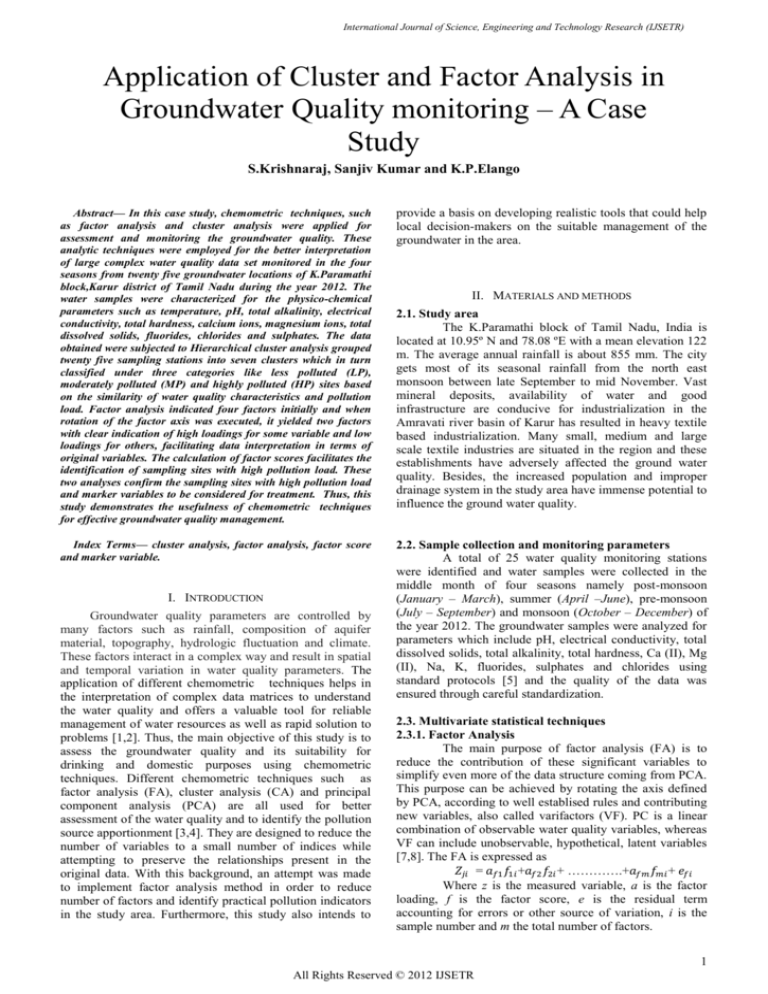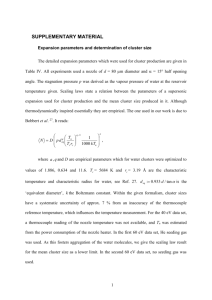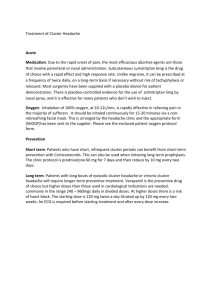
International Journal of Science, Engineering and Technology Research (IJSETR)
Application of Cluster and Factor Analysis in
Groundwater Quality monitoring – A Case
Study
S.Krishnaraj, Sanjiv Kumar and K.P.Elango
Abstract— In this case study, chemometric techniques, such
as factor analysis and cluster analysis were applied for
assessment and monitoring the groundwater quality. These
analytic techniques were employed for the better interpretation
of large complex water quality data set monitored in the four
seasons from twenty five groundwater locations of K.Paramathi
block,Karur district of Tamil Nadu during the year 2012. The
water samples were characterized for the physico-chemical
parameters such as temperature, pH, total alkalinity, electrical
conductivity, total hardness, calcium ions, magnesium ions, total
dissolved solids, fluorides, chlorides and sulphates. The data
obtained were subjected to Hierarchical cluster analysis grouped
twenty five sampling stations into seven clusters which in turn
classified under three categories like less polluted (LP),
moderately polluted (MP) and highly polluted (HP) sites based
on the similarity of water quality characteristics and pollution
load. Factor analysis indicated four factors initially and when
rotation of the factor axis was executed, it yielded two factors
with clear indication of high loadings for some variable and low
loadings for others, facilitating data interpretation in terms of
original variables. The calculation of factor scores facilitates the
identification of sampling sites with high pollution load. These
two analyses confirm the sampling sites with high pollution load
and marker variables to be considered for treatment. Thus, this
study demonstrates the usefulness of chemometric techniques
for effective groundwater quality management.
provide a basis on developing realistic tools that could help
local decision-makers on the suitable management of the
groundwater in the area.
Index Terms— cluster analysis, factor analysis, factor score
and marker variable.
2.2. Sample collection and monitoring parameters
A total of 25 water quality monitoring stations
were identified and water samples were collected in the
middle month of four seasons namely post-monsoon
(January – March), summer (April –June), pre-monsoon
(July – September) and monsoon (October – December) of
the year 2012. The groundwater samples were analyzed for
parameters which include pH, electrical conductivity, total
dissolved solids, total alkalinity, total hardness, Ca (II), Mg
(II), Na, K, fluorides, sulphates and chlorides using
standard protocols [5] and the quality of the data was
ensured through careful standardization.
I. INTRODUCTION
Groundwater quality parameters are controlled by
many factors such as rainfall, composition of aquifer
material, topography, hydrologic fluctuation and climate.
These factors interact in a complex way and result in spatial
and temporal variation in water quality parameters. The
application of different chemometric techniques helps in
the interpretation of complex data matrices to understand
the water quality and offers a valuable tool for reliable
management of water resources as well as rapid solution to
problems [1,2]. Thus, the main objective of this study is to
assess the groundwater quality and its suitability for
drinking and domestic purposes using chemometric
techniques. Different chemometric techniques such as
factor analysis (FA), cluster analysis (CA) and principal
component analysis (PCA) are all used for better
assessment of the water quality and to identify the pollution
source apportionment [3,4]. They are designed to reduce the
number of variables to a small number of indices while
attempting to preserve the relationships present in the
original data. With this background, an attempt was made
to implement factor analysis method in order to reduce
number of factors and identify practical pollution indicators
in the study area. Furthermore, this study also intends to
II. MATERIALS AND METHODS
2.1. Study area
The K.Paramathi block of Tamil Nadu, India is
located at 10.95º N and 78.08 ºE with a mean elevation 122
m. The average annual rainfall is about 855 mm. The city
gets most of its seasonal rainfall from the north east
monsoon between late September to mid November. Vast
mineral deposits, availability of water and good
infrastructure are conducive for industrialization in the
Amravati river basin of Karur has resulted in heavy textile
based industrialization. Many small, medium and large
scale textile industries are situated in the region and these
establishments have adversely affected the ground water
quality. Besides, the increased population and improper
drainage system in the study area have immense potential to
influence the ground water quality.
2.3. Multivariate statistical techniques
2.3.1. Factor Analysis
The main purpose of factor analysis (FA) is to
reduce the contribution of these significant variables to
simplify even more of the data structure coming from PCA.
This purpose can be achieved by rotating the axis defined
by PCA, according to well establised rules and contributing
new variables, also called varifactors (VF). PC is a linear
combination of observable water quality variables, whereas
VF can include unobservable, hypothetical, latent variables
[7,8]. The FA is expressed as
𝑍𝑗𝑖 = 𝑎𝑓1 𝑓1𝑖 +𝑎𝑓2 𝑓2𝑖 + ………….+𝑎𝑓𝑚 𝑓𝑚𝑖 + 𝑒𝑓𝑖
Where z is the measured variable, a is the factor
loading, f is the factor score, e is the residual term
accounting for errors or other source of variation, i is the
sample number and m the total number of factors.
1
All Rights Reserved © 2012 IJSETR
International Journal of Science, Engineering and Technology Research (IJSETR)
Factor analysis attempts to explain the
correlations between the observations in terms of the
underlying factors, which are not directly observable [9].
There are three stages in factor analysis [10]:
Step: 1(Number of Factors)
The number of factors needed to explain correlation
among the variables can be determine by the method
similar to determine the number of Principal
component that should be retained in PCA.(The most
popular nourishes are the eigen value – greater than
one rule and the Scree plot).
Step: 2 (Factor solution)
The factor pattern matrix gives the pattern or
structure loadings. The sum of the squared pattern
loadings for a given factor is the communality of all the
variables with that factor and is given by the eigen
value of the factor. The main objective of the factor
analysis is to explain the inter correlation among the
variables and not to account for the total variation in
the data.
Step: 3 (Assess the estimated factor solution
One can examine the correlation among the
indicator after the effect of the factors has been partial
led out.It is obvious that for a good factor solution the
resulting partial correlations should be close to zero,
because once the effect of the common factors has been
removed there is nothing to link the indicators.
2.3.2. Cluster Analysis
Cluster analysis is a technique used for combining
observations in to groups or clusters such that
i) Each group or cluster is homogeneous or compact
with respect to certain characteristics. That is,
observations in each group are similar to each other.
ii)Each group should be different from other groups
with respect to the same characteristics ie
observations of one group should be different from
the observations of other groups.
Note: The objective of cluster analysis appears to be
similar to that of factor analysis. It is therefore possible
to use FA to cluster observations, and to use cluster
analysis to cluster variables. The FA techniques used to
cluster observations is known as Q- factor analysis.
2.3.2.1. Objective of Cluster Analysis
The objective of cluster analysis is to group
observations into cluster such that each cluster is as
homogeneous as possible with respect to the
clustering variables.
Step: 1 Select a measure of similarity
Step: 2 Type of clustering technique to be used (e.g.
Hierarchical or non-hierarchical).
Step: 3 Type of clustering method for the selected
technique is selected.
Step: 4 Decision regarding the number of cluster is
made.
Step: 5 Interpretation of cluster solution.
III. RESULTS AND DISCUSSION
The groundwater samples collected during the four
seasons were analyzed using standard methods and their
descriptive statistical data is presented in Table 1,2,3 and
4.The data obtained from the laboratory analysis were used
as inputs for factor analysis (FA) as well as cluster analysis
(CA). This analysis was performed using the XLSTAT
2013 software.
3.1 Factor reduction and marker variables
The results of the present study indicated
that the water is alkaline in nature. The average pH values
varied from 7.0 – 8.1 (post-monsoon), 7.3 -8.4 (summer),
7.1 - 8.2 (pre-monsoon) and 7.3 – 8.5 (monsoon). The
average EC values varied between 1168 – 4120, 1068 –
3851, 1089 – 4098, 1210 - 4532 µS during post-monsoon,
summer, pre-monsoon and monsoon seasons, respectively.
The average total dissolved solids (TDS) values varied from
138 - 2945 mg L-1 (post monsoon), 792 - 2852 (summer),
856-3026 (pre monsoon), and 941 - 3208 (monsoon). The
total hardness (TH) and other parameters are found to be
within the permissible limit except fluoride which was
found to exceed the limit in certain sampling points and
varies slightly with seasons.
The Eigen value, percentage of variance and
cumulative percent calculated are shown in the Table 5 and
6.The analysis generated four factors (Eigen value greater
than unity) which accounted for 63.6%, 59.5 %, 57.5% and
56.6 % of the total variance in post-monsoon, summer, premonsoon and monsoon seasons, respectively. After varimax
rotation, each original variable tends to be associated with
one (or a small number) of the factors and each factor
represents only a small number of variable. Table 4 shows
the factor pattern of water quality parameters after varimax
rotation for the four seasons (2012).
The parameters are grouped based on
the factor loadings. Factor 1 exhibited 26.9% of the total
variance of 52.1 % with strong positive loadings for EC and
TDS in post-monsoon season, 26.4% of the total variance
of 48.1 % with strong positive loadings for EC and TDS in
summer season, 24.7% of the total variance of 47 % with
strong positive loadings for EC and TDS in pre-monsoon
and 25.1% of the total variance of 46.4% with strong
positive loadings for EC and TDS in monsoon season.
These high loadings represent a relative high correlation
between each other. Factor 2 exhibited 25.1% with strong
loading of SO4 and moderate positive loading for pH in
post-monsoon, 21.7% with strong loading of SO4 and
moderate positive loadings for pH in summer, 22.2% with
strong loading of SO4 and moderate positive loading for pH
in pre-monsoon and 21.2% with moderate positive loading
for pH and SO4 in monsoon season. The above results
indicates that in all the four season factor 1 exhibits EC and
TDS as strong positive loadings and factor 2 exhibits SO 4
as strong positive loadings.
The factor scores were then calculated for all 25
monitoring stations and are shown in Table 7 and 8. In postmonsoon, the high scores for Factor 1 were observed at
stations 1, 3, 8,10and 19. During this season, the high
scores for Factor 2 were observed at stations 3, 5,8,19 and
24. In the case of summer season, the high scores for Factor
1 were observed at stations such as 1, 2,4,10 and 15 and the
high scores for Factor 2 were observed at stations
2,11,17,21 and 22. In pre-monsoon season, the high scores
for Factor 1 were observed at stations 1, 2, 4,7,10 and 15,
the high scores for Factor 2 were observed at stations 1, 2
and 17. During the monsoon season, the high scores for
2
All Rights Reserved © 2012 IJSETR
International Journal of Science, Engineering and Technology Research (IJSETR)
Factor 1 were observed at stations 1, 2, 4,10,15,16 and 25
and the high scores for Factor 2 are 3, 8 and 19.
These findings reveal the fact that twelve water
quality parameters listed in the present study can be
represented by factors 1 and 2 and these could be used as an
indicator for potential contamination. In other words, any
arbitrarily selected parameter from factor 1 and 2 could be
used as a ‘marker’ variable to detect potential
contamination. For the present investigation, the probable
candidates for this purpose could be any one of the easily
measured parameters such as EC or TDS for factor 1 and
Total hardness TH or SO4 for factor 2 in all the four
seasons. Similar approach of deriving a marker variable
through factor analysis has been reported [8].
3.2 Spatial similarity and site grouping
Cluster analysis was used to detect the
similarity groups between the sampling sites. It yielded a
dendrograms (Fig 1,2,3and 4) and profile plots(Fig
1A,2A,3A and 4A), grouping all 25 sampling sites of
K.Paramathi block into six statistically significant clusters
during post monsoon season. The Cluster 1, composed of
the sampling stations assigned by numbers 1,4,7,9,10,11and
15 (central object 11) concerns 28 % of the total water
samples, Cluster 2 represented by sample numbers 2,13
and 14(central object 14) occupies 12 % of the total water
samples and Cluster 3 includes sample numbers 3,8 and 19
(central object8) corresponds to highly polluted (HP) sites.
The Cluster 4, composed of the sampling stations assigned
by number 5 concerns 4 % of the total water samples,
Cluster
5
represented
by
sample
numbers
6,12,16,20,21,23,24 and 25 (central object 20) occupies 32
% of the total water samples corresponds to moderately
polluted (MP) sites. The Cluster 6, composed of the
sampling stations assigned by numbers 17and 22 (central
object 17) concerns 8 % of the total water samples and
Cluster 7 represented by sample number 18 occupies 04 %
of the total water samples corresponds to Low polluted
(LP) sites.
Summer season: Cluster 1, composed of the sampling
stations assigned by numbers 1,2,4,6,7,9,10,11,12,15,16
and 23 (central object 15) concerns 48 % of the total water
samples,
Cluster 4 represented by sample numbers
13,14,18,20,21 and 25(central object 21) occupies 24 % of
the total water samples and Cluster 5 includes sample
numbers 17and 22 (central object17) occupies 08% of the
total water samples corresponds to highly polluted (HP)
sites. The Cluster 2, composed of the sampling stations
assigned by number 3,8 and 19 ( central object 3)concerns
12 % of the total water samples, Cluster 6 represented by
sample number 24 occupies 4 % of the total water samples
corresponds to moderately polluted (MP) sites. The Cluster
3, composed of the sampling station assigned by number 5
concerns 4 % of the total water samples corresponds to Low
polluted (LP) sites.
Pre monsoon season: Cluster 1, composed of the
sampling
stations
assigned
by
numbers
1,4,6,7,9,10,11,15and 23 (central object 15) and concerns
36 % of the total water samples, Cluster 2 represented by
sample numbers 2,13,14,18,20,21 and 25(central object 14)
occupies 28 % of the total water samples, Cluster 6
represented by sample number 16 (central object 16)
occupies 4 % of the total water samples and Cluster 7
includes sample numbers 17 and 22 (central object17)
corresponds to highly polluted (HP) sites. The Cluster 3
composed of the sampling stations assigned by number 3,8
and19( central object 3) concerns 12 % of the total water
samples, Cluster 5 represented by sample number 12
occupies 4 % of the total water samples corresponds to
moderately polluted (MP) sites. The Cluster 4, composed of
the sampling stations assigned by number 5 concerns 4 %
of the total water samples and Cluster 8 represented by
sample number 24 occupies 4 % of the total water samples
corresponds to Low polluted (LP) sites.
Monsoon season: Cluster 1, composed of the sampling
stations assigned by numbers 1,4,6,7,9,10,11and 15 (central
object 11) concerns 32 % of the total water samples,
Cluster
2
represented
by
sample
numbers
2,8,13,14,18,20,21 and 25(central object 25) occupies 32 %
of the total water samples, Cluster 3 represented by sample
number 3 and19 (central object 3) occupies 8 % of the
total water samples Cluster 5 includes sample numbers 12
and 16 (central object12) occupies 8 % of the total water
samples, Cluster 6 includes sample numbers 17 and 12
(central object17) concerns 8 % of the total water samples
corresponds to highly polluted (HP) sites. The Cluster 7
composed of the sampling stations assigned by number 23
occupies 4% of the total water samples and Cluster 8
represented by sample number 24 occupies 4 % of the total
water samples corresponds to moderately polluted (MP)
sites. The Cluster 4, composed of the sampling stations
assigned by number 5 concerns 4 % of the total water
samples corresponds to Low polluted (LP) sites.
From the outcome of the factor analysis and cluster
analysis, the sampling sites assigned by the numbers
1,3,8,10
and
19
in
post
monsoon
season,
1,2,4,10,11,15,17,21 and 22 in summer season,1,2,4,7,10
and 10 in pre monsoon and 1,2,3,4,8,10,15,16,19 and 25 in
monsoon season were identified as the highly polluted .
IV. CONCLUSION
This investigation employed two important
chemometric techniques and evaluated spatial and temporal
variations in the groundwater quality of K.Paramathi block,
Tamil Nadu. This case study revealed that factor analysis
helped to extract factors and identify the marker variable
responsible for variations in the groundwater quality at
different sampling sites. Besides, the cluster analysis
grouped 25 sampling sites into seven clusters of similar
water quality characteristics, which were further classified
under three categories respectively highly polluted,
moderately polluted and low polluted sampling sites. Based
on this outcome, it is possible to design a future optional
sampling strategy, which could reduce the number of
sampling stations and associated costs. This case study with
K.Paramathi block as a model system demonstrated the
scope of chemometric analytical techniques for analysis and
interpretation of complex datasets to undertake meaningful
decisions for effective management of groundwater quality.
Such techniques need to be explored to save crucial
response time to potential contamination risks.
3
All Rights Reserved © 2012 IJSETR
International Journal of Science, Engineering and Technology Research (IJSETR)
V. TABLES AND FIGURES
Table 5. Eigen value (EV), percentage of variance (V)
Table 1. Descriptive statistical data of groundwater samples
during post-monsoon
Post-monsoon
Std.
Variable
Minimum
Maximum
Mean
Deviation
EC
1168
4120
2425
734.5
TDS
138
2945
1729
617.6
TA
193
495
303
75.2
TH
142
810
362
170.3
pH
7.0
8.1
7.3
0.3
Ca (II)
82
234
135
41.9
Mg (II)
42
126
76
23.6
Na
132
450
249
101.4
K
20
49
35
7.1
F
0.3
48
2.4
9.4
SO4
54
195
104
44
Cl
125
575
278
115
Table 2. Descriptive statistical data of groundwater samples
during summer
Summer
Std.
Variable
Minimum
Maximum
Mean
Deviation
EC
1068
3851
2181
712.5
TDS
792
2852
1617
516.0
TA
208
562
344
78.5
TH
102
698
358
143.1
pH
7.3
8.4
7.7
0.2
Ca (II)
86
295
155
47.9
Mg (II)
22
128
60.2
30.5
Na
128
454
246
102.7
K
23
52
35
7.1
F
0.25
0.93
0.51
0.17
SO4
52
178
107
38.8
Cl
138
572
295
117.2
and cumulative percent (C)
Factor
1
2
3
4
5
6
Post-monsoon
EV
V (%) C (%)
3.52
29.4
29.4
2.73
22.74
52.14
1.38
11.53
63.67
0.77
6.47
70.15
0.36
3.06
73.21
0.18
1.53
74.74
EV
3.29
2.49
1.36
0.98
0.29
0.16
Summer
V (%)
27.47
20.77
11.34
8.20
2.42
1.35
C (%)
27.47
48.24
59.58
67.78
70.20
71.56
Table6. Eigen value (EV), percentage of variance (V)
and cumulative percent (C)
Factor
1
2
3
4
5
6
Post-monsoon
EV
V (%) C (%)
3.12
26.02
26.02
2.52
21.06
47.08
1.26
10.49
57.57
0.94
7.83
65.41
0.28
2.37
67.79
0.15
1.30
69.08
EV
3.04
2.52
1.22
1.05
0.27
0.07
Summer
V (%)
25.36
21.03
10.23
8.78
2.25
1.89
C (%)
25.36
46.40
56.63
65.42
67.67
69.56
Table 3. Descriptive statistical data of groundwater samples
during post-monsoon
Pre-monsoon
Std.
Variable
Minimum
Maximum
Mean
Deviation
EC
1089
4078
2372
741.2
TDS
856
3026
1755
540.9
TA
184
496
301
75.5
TH
96
640
319
139.9
pH
7.1
8.2
7.5
0.27
Ca (II)
56
229
129
40.6
Mg (II)
24
113
56
22.8
Na
102
432
223
101.0
K
23
46
33.3
6.5
F
0.3
0.82
0.503
0.14
SO4
49
165
99
33.7
Cl
106
532
273
109.3
Table4. Descriptive statistical data of groundwater samples
during monsoon
monsoon
Std.
Variable
Minimum
Maximum
Mean
Deviation
EC
1210
4532
2608
808.5
TDS
941
3208
1886
577.05
TA
22
545
326
103.6
TH
96
718
351
154.4
pH
7.3
805
7.7
0.316
Ca (II)
64
252
144
44.2
Mg (II)
22
101
49
20.3
Na
112
451
234
97.5
K
21
43
31
5.9
F
0.3
0.9
0.57
0.17
SO4
52
182
109
37.1
Cl
111
585
302
119.9
4
All Rights Reserved © 2012 IJSETR
International Journal of Science, Engineering and Technology Research (IJSETR)
Table 7. Factor scores after varimax rotation
Dendrogram
-0.352738
-0.152738
0.0472623
Similarity
0.2472623
0.4472623
0.6472623
0.8472623
Obs16
Obs23
Obs11
Obs24
Obs6
Obs10
Obs19
Obs17
Obs20
Obs12
Obs22
Obs25
Obs1
Obs13
Obs4
Obs14
Obs2
Obs8
Obs7
Obs5
Obs15
Obs21
Obs3
Obs9
Obs18
Summer
Factor
Factor
1
2
0.486
2.081
1.563
1.913
0.393
-2.261
0.097
2.193
-0.735
-1.041
-0.560
0.084
0.117
-0.534
0.409
-2.092
-0.667
-0.397
1.115
-0.483
-0.103
0.968
-0.858
0.034
-0.323
-0.389
0.157
-0.086
0.570
1.163
0.385
0.321
-0.330
1.465
-0.917
0.306
0.230
-1.741
0.403
-0.686
-0.712
0.851
-0.698
1.058
-0.395
-1.044
0.740
-1.298
0.408
-1.160
Fig.1: Dendrogram showing clustering of sampling sites
in post monsoon season
Dendrogram
-0.352738
-0.152738
0.0472623
Similarity
Sampli
ng
Station
1
2
3
4
5
6
7
8
9
10
11
12
13
14
15
16
17
18
19
20
21
22
23
24
25
Post-monsoon
Factor
Factor
1
2
-1.617
1.823
-0.059
-1.250
1.408
1.629
1.756
-1.797
-0.274
1.522
-0.158
-0.285
0.093
0.109
1.461
1.556
0.057
0.368
-0.195
0.926
0.295
-0.727
-0.292
0.332
-0.504
0.150
-0.057
-0.694
0.329
-1.103
-0.143
-0.612
-1.470
-1.110
-0.091
-1.109
1.443
1.555
0.688
-0.952
0.659
-0.882
-1.526
-1.057
-0.711
0.797
0.992
-1.105
0.609
-0.777
0.2472623
Table 8. Factor scores after varimax rotation
0.4472623
0.6472623
0.8472623
Obs16
Obs23
Obs11
Obs24
Obs6
Obs10
Obs19
Obs17
Obs20
Obs12
Obs22
Obs25
Obs1
Obs13
Obs4
Obs14
Obs2
Obs8
Obs7
Obs5
Obs15
Obs21
Obs3
Obs9
Obs18
Summer
Factor
Factor
1
2
0.434
2.028
-0.365
1.127
0.103
2.120
0.255
2.647
0.268
-0.912
0.068
0.142
-0.250
0.454
-0.317
1.571
0.393
-1.184
0.635
1.267
-0.224
-0.448
-0.920
-1.524
0.168
-1.032
-0.059
0.224
-0.148
1.502
-0.506
0.829
-0.340
-1.814
-0.493
-1.527
-1.106
1.953
0.036
-0.395
-0.653
-0.744
0.617
-1.790
0.094
-0.503
-0.485
-1.857
-0.559
1.221
Fig.2: Dendrogram showing clustering of sampling sites
in summer season
Dendrogram
-0.31518
-0.11518
0.0848196
0.2848196
0.4848196
0.6848196
0.8848196
Obs25
Obs12
Obs1
Obs13
Obs4
Obs14
Obs2
Obs8
Obs7
Obs21
Obs15
Obs9
Obs18
Obs3
Obs5
Obs16
Obs11
Obs10
Obs24
Obs6
Obs23
Obs22
Obs19
Obs17
Obs20
1
2
3
4
5
6
7
8
9
10
11
12
13
14
15
16
17
18
19
20
21
22
23
24
25
Post-monsoon
Factor
Factor
1
2
1.128
2.390
0.854
1.325
0.642
-2.223
0.459
1.908
-1.022
-0.972
-0.102
0.144
-0.220
0.980
0.374
-2.142
-0.469
-0.657
1.413
0.120
0.361
0.471
-0.981
0.508
-0.535
-0.607
-0.086
0.054
0.712
0.942
0.028
0.409
-0.669
1.196
-0.763
0.380
0.500
-1.941
0.330
-0.476
-0.690
0.877
-0.682
0.954
-0.790
-1.179
0.371
-1.359
0.113
-1.381
Similarity
Sampling
Station
Fig.3: Dendrogram showing clustering of sampling sites
in pre monsoon season
5
All Rights Reserved © 2012 IJSETR
International Journal of Science, Engineering and Technology Research (IJSETR)
[10]
[11]
[12]
C.W. Liu, K.H. Lin and Y.M. Kuo, Y.M, Application of factor
analysis in the assessment of groundwater quality in a blackfoot
disease area in Taiwan, Sci. Total Environ. 313, 2003, 77-89.
K. Bengraine and T.F. Marhaba, Using principal component
analysis to monitor spatial and temporal changes in water quality,
Journal of Hazardous Materials, B100, 179-195,2003.
M. Karthikeyan, Chemometric analysis of water quality
parameters in Dindigul district and removal of fluoride using
polymeric materials, doctoral diss., Gandhigram Rural Institute –
Demmed University, Gandhigram, 2010.
Dendrogram
-0.299285
-0.099285
Similarity
0.1007151
0.3007151
0.5007151
0.7007151
Obs12
Obs11
Obs6
Obs23
Obs7
Obs22
Obs25
Obs10
Obs16
Obs24
Obs18
Obs17
Obs20
Obs19
Obs9
Obs21
Obs1
Obs13
Obs14
Obs8
Obs2
Obs4
Obs5
Obs3
Obs15
0.9007151
Fig.4: Dendrogram showing clustering of sampling sites
in monsoon season
REFERENCES
[1]
[2]
[3]
[4]
[5]
[6]
.
[7]
V. Simeonov, P. Simeonova, and R. Tsitouridou, Chemometric
quality assessment of surface waters: two case studies, Chem. Eng.
Ecol. 11, 449-469,2004.
S. Shrestha and F. Kazama, Assessment of surface water quality
using multivariate statistical techniques: A case study of the Fuji
river basin, Japan, Environmental Modeling and Software, 22,
464-475,2007.
T.G. Kazi, M.B. Arain, M.K. Jamali, N. Jalbani, H.I. Afridi, R.A.
Sarfraz, J.A. Baig, and A.Q. Shah, Assessment of water quality of
polluted lake using multivariate statistical techniques: A case
study, Ecotoxicology and Environmental Safety,72, 301-309,2009.
L. Belkhiri, A. Boudoukha, L. Mouni, and T. Baouz, Multivariate
statistical characterization of groundwater quality in Ain Azel
plain, Algeria, African Journal of Environmental Science and
Technology, 4(8), 526-534,2010.
APHA, Standard methods for the examination of water and
wastewater (American Water Works Association, Washington
DC, 1985).
B. Helena, R. Pardo, M. Vega, E. Barrdo, J.M. Fernandez, L.
Fernandez, Temporal evolution of groundwater composition in an
alluvial aquifer ( Pisuerga river, spain) by principal component
analysis., Water Res. 34, 807- 816,2000.
M. Vega, R. Pardo, E. Barrado and L. Deban, Assessment of
seasonal and polluting effects on the quality of river water by
exploratory data analysis, Water Res.32, 3581-3592,1998.
[8]
S. Yu, J. Shang, and J. Zhao, Factor analysis and dynamics of
water quality of the Songhua River Northeast China. Water, Air &
Soil Pollution, 144, 159 – 169,2003.
[9]
A.K. Gupta, S.K. Gupta, and R.S. Patil, Statistical analyses of
coastal water quality for a port and harbor region in India.
Environ Monit. Assess., 179-200,2005.
6
All Rights Reserved © 2012 IJSETR







